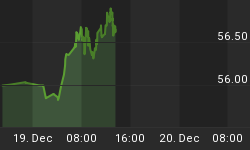Gold fell below $1,300 last week, to many analysts’ surprise. They are panicking right now. But you do not have to.
Didn’t we tell you?
We don’t want to be like these annoying guys who always utter “didn’t we tell you?”. But, well, this is our job after all: to provide you with the finest fundamental outlook of the precious metal market. And here is what we wrote in Gold News Monitor on May the 15th:
The weak rebound in gold prices last week suggests that gold has some work to do on the downside. Similarly, the fundamental outlook is rather bearish in the medium term, at least more bearish than a few weeks ago. We mean here that the stock market correction has not turned into a crisis and the risk appetite has increased. The worries about trade wars have diminished, while inflation remains in check. If interest rates continue their upward move and their correlation with gold returns, the yellow metal will get into hot water.
And the very next day, the price of gold sank below $1,300, as you can see in the chart below. You may call it a coincidence, but I would say that it was a comeback of a key gold correlation.

(Click to enlarge)
Chart 1: Gold prices (London P.M. Fix) over the last twelve months.
What Happened?
In short, the U.S. dollar rallied (see the chart below), which finally forced the yellow metal to react to the surging real interest rates. On Monday, the American currency hit a five-month high due to the U.S.-China trade war relief, as the chart below shows. So the bear market in gold continued.

(Click to enlarge)
Chart 2: EUR/USD exchange rate over the last twelve months.
As a reminder, the big news over the weekend was the possible deal made with China and the United States on the trade wars and tariffs. Beijing and Washington issued a joint statement after intensive trade talks in which China agreed to significantly increase its purchases of U.S. goods and services – in particular, energy and agricultural commodities – to reduce the $335 billion annual U.S. goods and services trade deficit with China. And following the statement, U.S. Treasury Secretary Steven Mnuchin declared the U.S.-China trade war “on hold”. It supports the risk appetite, which is negative for the gold prices.
Implications for Gold
The current gold’s outlook seems to be bearish. The trade wars diminished, reducing the safe-haven demand for the yellow metal. Inflation is still moderate in America. U.S. interest rates are rising (the 10-year yield has broken above 3.05 percent for the first time since 2011), making the greenback more attractive versus its major peers. And the Fed is expected to further raise the federal funds rate at the next meeting. Related: Can Anyone Compete With Netflix?
Moreover, concerns over fiscal policy in Italy are also weighing down on euro against the U.S. dollar (not to mention the fact that expectations of the ECB’s interest rate hike have been pushed back to mid-2019). We will elaborate more on Italy in the upcoming edition of the Market Overview.
Hence, gold plunged below the psychologically important level of $1,300 per ounce, marking a new low. Now, the question is: should we expect more weakness in gold? Well, we have no crystal ball. However, the medium-term outlook does not look encouraging right now. Actually, an irresponsible U.S. fiscal policy seems to be the only bullish gold’s driver in operation right now.
Based on recent gold’s history, we would say that gold may be under pressure until the FOMC meeting next month. But a lot will depend, of course, on the Fed’s communication, Trump’s rhetoric and actions, and the dollar’s performance. Gold is not sinking, but it flows into the restless sea. Stay tuned!
By Arkadiusz Sieron via Sunshine Profits
More Top Reads From Safehaven.com:
















